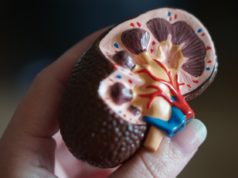
Further sub-group analysis of CORAL trial data indicates that retrieval of renal function after renal artery stenting improves survival and decreases cardiovascular and renal events. J Gregory Modrall, University of Texas Southwestern Medical Center, Dallas, USA, who presented the analysis at the Vascular Annual Meeting (9–11 June, National Harbor, USA), suggested that renal artery stenting in conjunction with angiotensin receptor blocker therapy may be beneficial in some patients with chronic kidney disease.
The multicentre, randomised, controlled CORAL trial concluded that there was no benefit of renal artery stenting over medical therapy. However, patients with chronic kidney disease (CKD)—a risk factor for cardiovascular and renal morbidity—were not analysed separately in this trial. Modrall and colleagues felt that this was “a key omission since this subset of patients likely has the most to gain from a favourable result.” In a post-hoc analysis, Modrall and colleagues hypothesised that improved renal function could improve long-term survival outcomes and lower the risk of cardiovascular and renal events in chronic kidney disease patients.
The analysis included 144 patients with chronic kidney disease at baseline (serum creatinine ≥1.5mg/dL), randomised to renal artery stenting plus angiotensin receptor blockade. Patients were categorised as “responders” (≥20% increase in estimated glomerular filtration rate [eGFR] compared to baseline) or “non-responders” (<20% increase in eGFR) based on late renal function response.
The median age of the cohort was 71 years (interquartile range (IQR), 65–76 years), and 61% were males. Median baseline serum creatinine was 1.75mg/dL (IQR 1.6–2), and median baseline eGFR was 35mL/min/1.73m2 (IQR 28–42).
Modrall reported that 38 of 144 patients (26%) were responders at late follow-up. Responders experienced a median increase in eGFR of 40% over baseline (IQR 29–61%); non-responders had a median decrease in eGFR of 11% (IQR -35%-6%; p<0.0001). Event-free survival (defined as freedom from death, myocardial infarction, transient ischaemic attack/stroke, hospitalisation for congestive heart failure, progressive renal insufficiency, or renal replacement therapy) was superior for responders, compared with non-responders (p=0.0097 by log-rank test). Higher preoperative eGFR and improvement in eGFR after stenting were associated with improved event-free survival (analysed using the Kaplan-Meier technique), whereas peripheral arterial disease and higher preoperative systolic blood pressure were associated with worse outcomes.
Modrall and colleagues also found that urine albumin/creatinine ratio (UACR)—a sensitive measure of microvascular disease of the kidney—was “the only independent predictor of renal function improvement.” A higher UACR corresponded with a lower probability of improved eGFR (odds ratio 0.997, 95% confidence interval 0.993–0.999, p=0.033). Modrall suggested that the optimal cut-off for UACR is <57.25mg/g.
“Our subgroup analysis shows improved renal function after renal artery stenting is associated with improved survival and fewer cardio-renal events,” Modrall said. “Taken together, these data suggest that there are subsets of patients that benefit from renal artery stenting, so the goal going forward should be to better characterise that phenotype of those patients to guide patient selection and improve outcomes for renal artery stenting.”
Modrall noted that there are currently two studies that have come to the same conclusion that the rate of decline of preoperative eGFR is a strong predictor of probability of improved eGFR after stenting. “A flat preoperative eGFR curve portends a very low likelihood of improved renal function as opposed to a steep decline of renal function preoperatively,” he said. “Based on our current data, I would now add to that the UACR. If that number is above 57mg/g, you should pause and look at that patient carefully because our data suggests that a high UACR only portends a lower probability of improved renal function, but a higher UACR also portends a higher probability of decay in renal function in the future. Although these data are intriguing, it must be recognised that sub-group analyses, such as this study, are hypothesis-generating, so these findings will require independent validation in future studies.”











